

The Great Christian Müller Organ of the St. Bavo Church in Haarlem, Holland
2016-06-27 - Sample Set Spotlight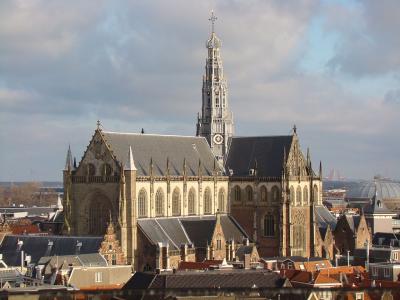
The great Church of St. Bavo, Haarlem, Holland.
I think all organists will agree that the 1738 Christian Müller organ at the St. Bavo Church in Haarlem, Holland is one of the world's great organs. Important for its beauty, its power and massive size, the glorious façade and the majestic acoustics in the huge church of St. Bavo, this famous instrument has few peers.
In this article, I will discuss some of the interesting historical facts about the instrument, show you a lot of wonderful pictures, give my impressions of the Voxus sample set, and finally, illustrate my opinions with a large number of recordings.
All of the opinions expressed are solely my own, and based upon my experience with the sample set being reviewed.
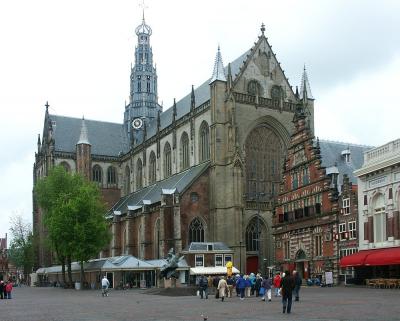
It seems that life "on the street" is ALWAYS busy around the church!
This late Gothic basilica is on the site of an earlier St. Bavo church mentioned as early as 1245. According to its official web site, the choir was built in 1370-1400 by Brecht Enge of Nivelles made in "brick Gothic" with economical use of sandstone while the transept was added in the mid-15th century in the "style of the classic Brabant Gothic." The construction of the nave was performed by master Evert Rail Water in 2 phases in the second half of the 15th century. The original crossing tower was a 16th century design.
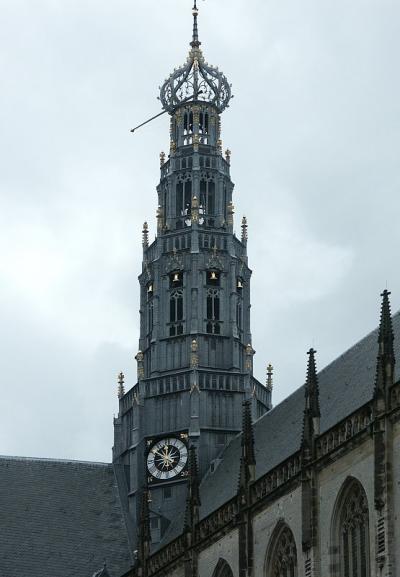
The magnificent "crown" bell tower.
The church, built in the Gothic style, is an important landmark for the city of Haarlem and has dominated the city skyline for centuries. The very first St. Bavo Church was mentioned in 1245 and was already considered prominent, among other things because of its belfry. The first part that was constructed of the new church was the choir. It was built from 1370 until 1400, and the transept was built from 1445 to 1455. The nave was finished in 1478.
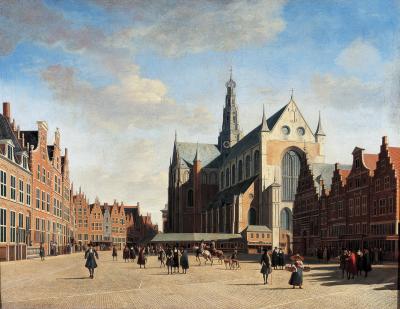
As I said above, life is ALWAYS busy around St. Bavo's!
I consider myself to be a "saintly wise guy" meaning that I know my saints and my church history, but I have to admit that I know absolutely nothing about Saint Bavo. So, before we talk about his majestic church and its glorious instrument, let's learn a little about the man himself.

St. Bavo "in action"!
Saint Bavo of Ghent is a Roman Catholic and Eastern Orthodox saint, born near Liège, Belgium, to a Frankish noble family that gave him the name Allowin. A wild, young aristocrat of Brabant, he was a soldier who led an undisciplined and disorderly life. Shortly after the death of his wife, Bavo decided to reform upon hearing a sermon preached by Saint Amand. Bavo was struck after the sermon at the emptiness of material objects and donated his wealth to the poor after he converted to Christianity at Amand's convent. Bavo traveled with Amand for some time in his missionary work through France and Flanders. He built an abbey on his grounds and became a monk. He distributed his belongings to the poor and lived as a recluse, first in a hollow tree, later in a cell in the forest near the Abbey. He died at St. Bavo's Abbey in Ghent, in today's Belgium. He is the patron saint of Ghent and Lauwe, Belgium and Haarlem, the Netherlands. His feast day in the Orthodox Church is October 1.
Light fills the interior of the Church of Saint Bavo in Haarlem, one of the finest Gothic buildings still in existence today. Although Pieter Jansz. Saenredam based his work on careful on-the-spot studies, the painting combines two distinct views, one looking straight ahead and the other toward the chancel on the left. He even added an altarpiece and a stained glass window, which would probably already have been removed from the church by Saenredam's time. By the 1600s, Protestant churches in Holland had become relatively austere in response to the teachings of theologian John Calvin.
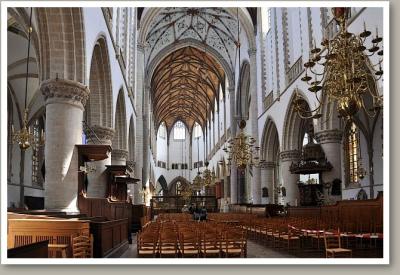
Standing "under" the great organ, looking toward the Choir.
The overall impression is one of strong verticality, soaring space, and penetrating light, a spiritual reference to the heavens above. The inclusion of small figures accentuate the viewer's experience of exalted interior space. Saenredam described architectural elements in great detail: vaulted ceilings, moldings, decorative capitals, clustered pillars, and clerestory windows.
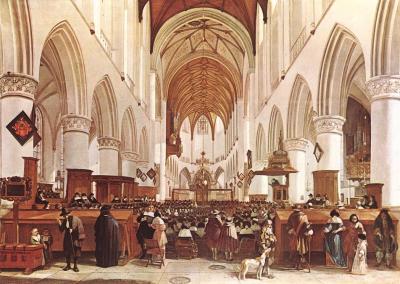
The 1673 painting by Geritt Berckheyde gives a full view of the interior. Notice the dog, and the gentleman to the left admonishing the children to behave!
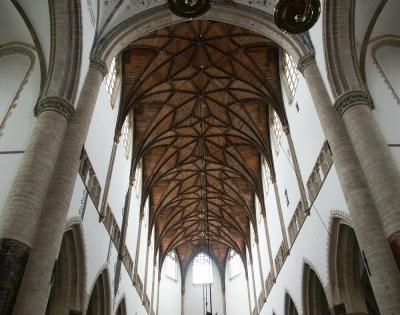
The unique and magnificent wooden vaulting dates to the 16th century.
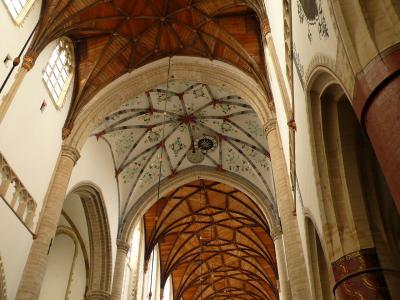
Under the central tower.
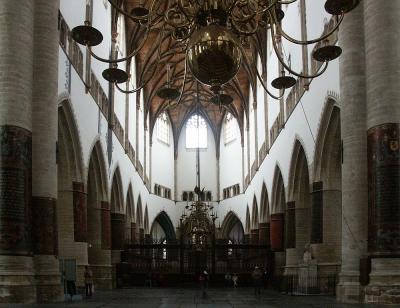
A distant view of the Choir screen.
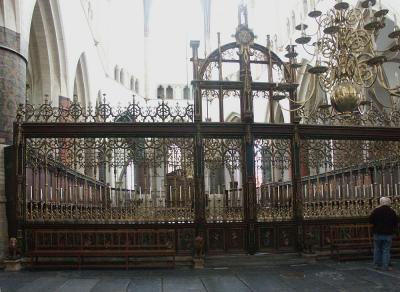
The magnificent Choir Screen is truly glorious!
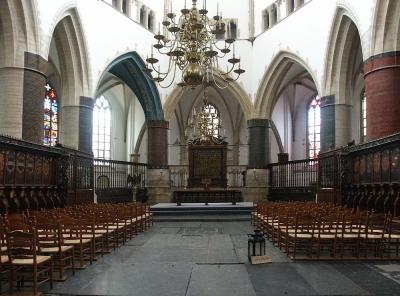
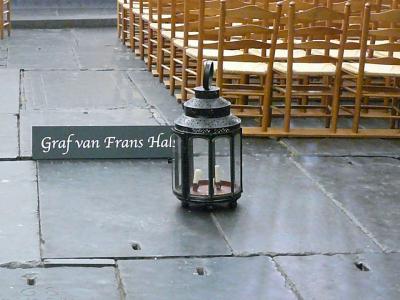
The grave of Frans Hals within the Choir.
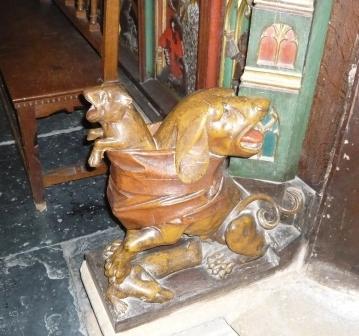
The wonderful dog, who has a permanent home in the Choir!
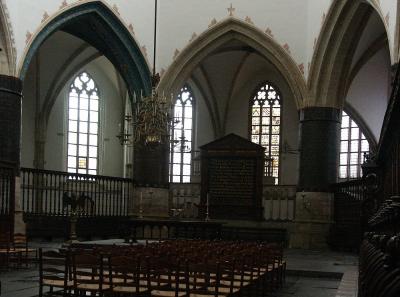
Another view of the Choir.
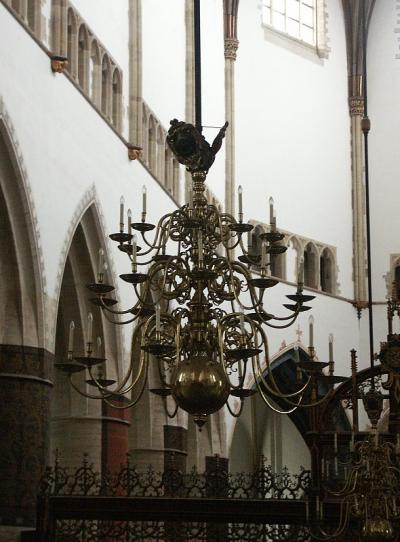
Magnificent lights fill the St. Bavo church.
The north aisle of the Choir.
Unique carvings and artwork are striking.
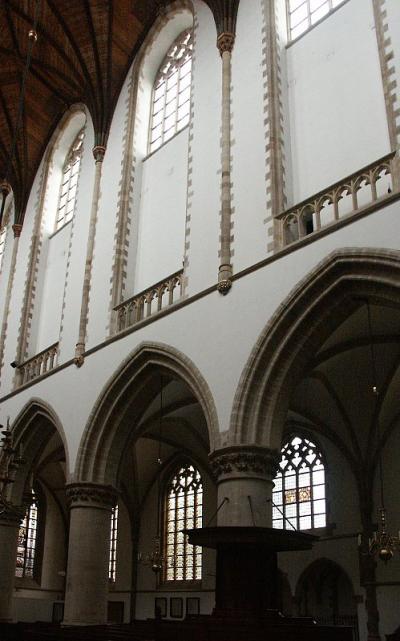
A view of the huge Nave.
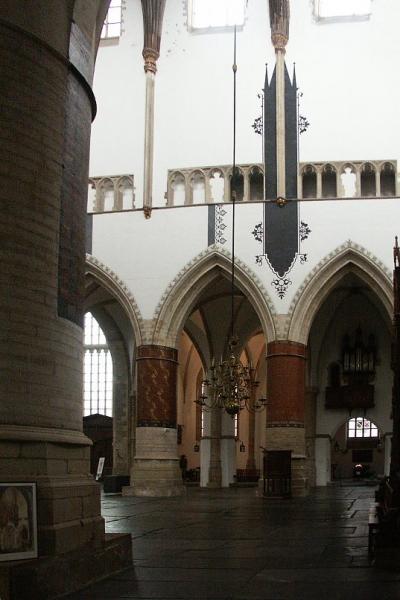
Another view of the Nave.
Let's take a look at three paintings by Pieter Jansz Saenredam, which I personally find very interesting, as they present a good "historic look" at the church, and make excellent reference points for looking at the way things "used to be," and all the way through to the modern church.
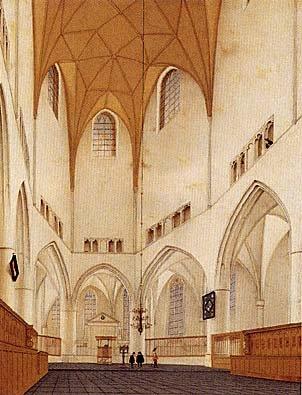
This first one, dating from 1660, shows the Choir area, toward the front of the church.
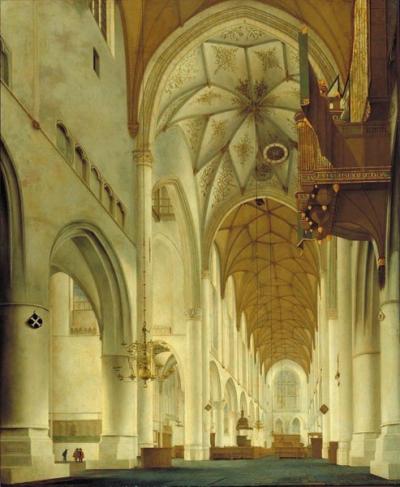
The second one, dating from 1648, shows the Nave, as well as a little of the North Transept. Now, if you look up to the right, I think we get a view of the organ in the church at that time. It appears as though we can see the organist sitting at the console.
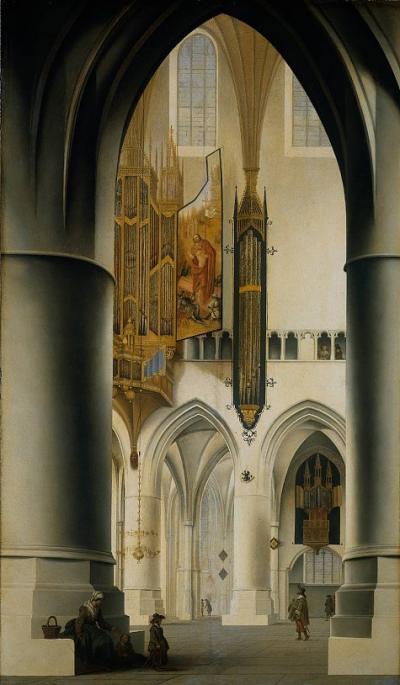
Here is another one that is looking across the nave between the pillars. Again we see the organ, in what appears to be a magnificent "triptych-like" arrangement. It's possible that the side "panels" or "doors" can be folded in, to "close" the organ.
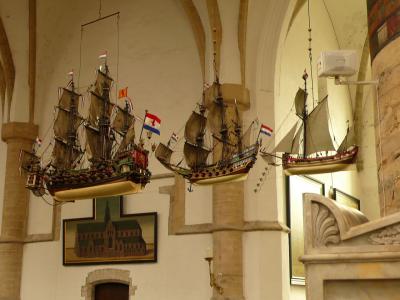
Another highly interesting feature of the Bavo Church are the famous and magnificent ship models that are present.
conquered Damiate in 1219. They are examination pieces to be admitted to the
guild of Seafarers and date from the mid-17th century. They are three different
types of 13th century sailing vessels. Altogether there are 5 small ships in the
St. Bavo. In 1668 they were donated to the church by the wealthy Haarlem tradesman
David Koenen.
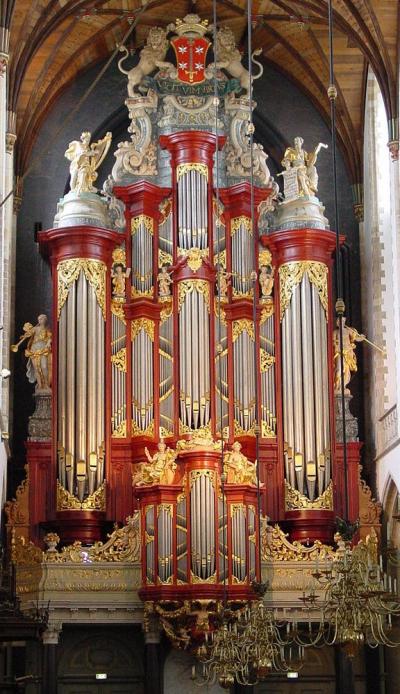
The great organ's façade. This feature alone cost 37,000 gulden!
The organ of the St-Bavo church is one of the world's great organs. It was built by Christian Müller and Jan van Logteren, from Amsterdam, between 1735 and 1738. Upon completion it was the largest organ in the world with 60 voices and 32-feet pedal-towers. It possesses 3 keyboards, 64 stops, and 5000 pipes, the largest of which is l5 inches in diameter and 32 ft. long. Many famous people played this organ, including Mendelssohn, Handel and the 10-year old Mozart. The organ was modified a number of times in the 19th and 20th century. These changes were undone in the restorations between 1959 and 2000. A local story goes to say that the bass of the organ was so low, the mortar in between the brimstones started to brittle to nothing.
The organ occupies the whole west wall of the church and measures almost 30 metres from the ground. The official web site explains that "the organ is richly gilded and decorated with more than 25 larger than life-size statues, all made by Jan van Logteren, a sculptor from Amsterdam. The pinnacle is crowned with two lion figures holding the coat of arms of Haarlem. The pinnacle is Crowned with two lion figures holding the coat of arms of Haarlem.
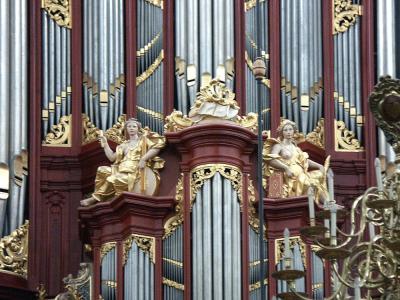
Some life sized figures adorn the case, sitting here on top of the Rugwerk.
Because of its unique and grandiose prospects, the great organ in the Grote Kerk, Haarlem, must unquestionably be considered one of the most famous in the world. On March 14, 1735, the municipal authorities of Haarlem commissioned the building of the organ to Antonio Christianus Müller, a student of Arp Schnitger. Of the 59,000 gulden given him, Müller spent 37,000 on the facade alone!
Several changes were made on the organ by. C. G. F. Witte in 1866, and it underwent a thorough "restoration" in 1959-1961 by the Danish firm of Marcussen and Son of Aabenraa. The organ contains sixty-two stops on three manuals and pedal.
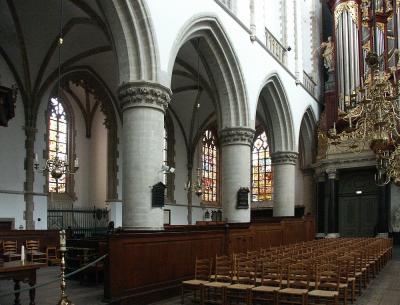
Looking westwards in the Nave, and back towards the organ.
I, along with many others, was very excited when Voxus released the original "wet" version of this instrument over a year ago. While I found it to be finely done, the effect heard really did not capture the full glory of the instrument or the acoustical environment.
I think that the sound "portrayed" probably did give a good feel for sitting at the console, sort of "hidden" behind the Rugwerk. The great "rolling echo" was there, but it felt like you were "closed in a room" and the sound was "outside" of where you were located. The sound was compelling, although the organ is so famous, that expectations were very high. Although I liked and made use of this "wet" version, I also felt a sense of disappointment.
However - ALL that changed with the release of the "surround" version! The sounds, the grandeur, the presence are all here in abundance. The "location slider" is very easy to use and the effect/s it produces seem to me to be spot on.
The "original front" (near) samples have been "replaced," so this sample set is ENTIRELY NEW, and does not use the samples used in the "wet" set.
From a technical standpoint, I never experienced a single "bug" or "glitch" during my use of the instrument, and I used it a LOT - making and uploading more than 20 recordings.
I began my article with a statement that the Müller organ was one of the world's great ones, but after all, there are many great organs in the world. SO many! So many types and sizes with their inherent strengths and weaknesses. Yes, even a great organ can (and does!) have weaknesses.
So, WHAT is it that makes an great? Opinions will be as varied as there are organ types, and it's just not size or age that makes an organ great. Let's take some time to look and listen to this instrument in detail and under close scrutiny. I think you will agree with me that this is an instrument where "divine inspiration" must surely have guided the hands of the builders!
To me, the factors that will make an organ great would include the following things: the specification, the versatility, the acoustical environment, and, usually, the location, almost always a church or cathedral, where the organ is housed. So, before I get to why I think the St. Bavo Müller is one of the world's great organs, let me discuss the "things" that I think make an organ great.
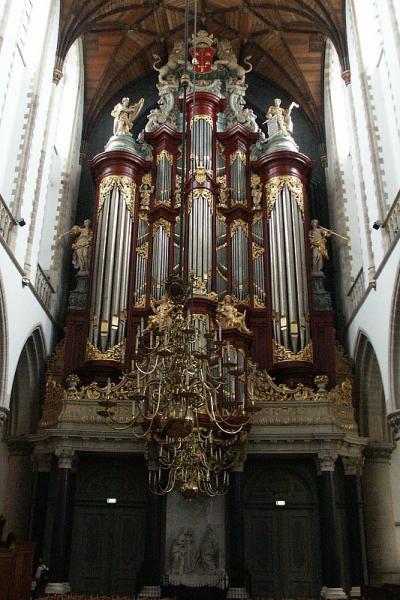
How glorious and majestic!
The specification - it's not just the stops or how many there are, it's the sound - the voicing, the way the organ speaks. It's the way the stops can stand on there own, as well as how they combine into singing choruses of grandeur. I think this "voicing" and "singing" would go towards the "versatility" of the organ.
By versatility, I mean the organ's ability to play diverse styles and forms of literature, as well as being a solid and inspiring "church" instrument. When I say versatility, it doesn't mean that I expect each organ to play all styles with the same sense of "correct historical" sound. That just isn't possible! However, if you have an organ that can play nothing but English Victorian, French Baroque, German Romantic, or spiky American modern, with a sound about as "warm" as getting poked in the ear by an ice pick, you or going to have difficulty making music on the instrument, unless of course you are only interested in playing the one kind of music that your organ is "designed" for.
Next, let's talk about the acoustical environment. Here again, opinions vary. We organists tend to like a lot more reverberation than does the average person. We see this "rolling echo" is an enhancement, where most people would call it an annoyance, making it difficult to hear the preacher's words. Even organists will differ in what they think makes a "perfect" acoustical home for the instrument. I like a lot of reverberation. I like a truly "liquid feel" to the room. Others will prefer a "live" room, but don't really like that "acoustic blurring" of the sound.
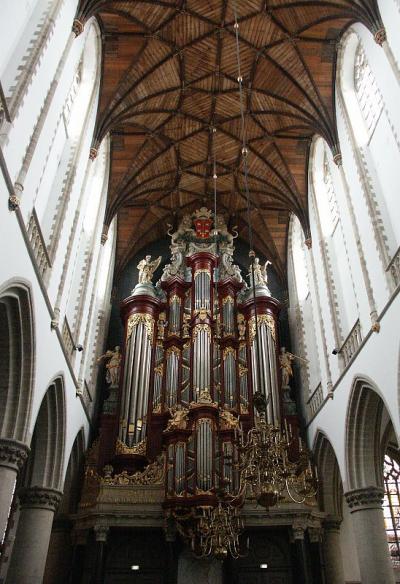
The mighty Müller, also showing the distinctive wooden vaulting.
Finally the instrument's "home" makes a significant difference to me. This could be because of intense interest and devotion to the church. To me, the highest calling of our profession is to serve as a liturgical musician. This being said, an organ installed in a famous or "important" church or cathedral, immediately feels "greater" to me. For instance, if I think of the organ in Westminster Abbey, I automatically think of it as a great instrument. In reality, while it is a grand instrument indeed, it's probably far more "important" because of where it lives, as opposed to the fact that it is a "uniquely significant" instrument.
So, enough of my general opinions, let's turn the St. Bavo Müller and see, in detail, why this is one of the great organs of the world. Let's start at the beginning by studying the specification or as some would call it, the disposition.
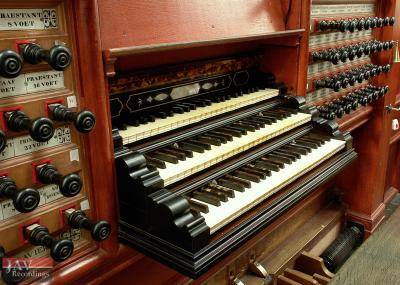
The organ console. (Notice the little "hand letterings" which appear to be TAPED next to the keyboards! I assume these are for visiting organists and guests!)
I Hoofdwerk C–d3
1. Praestant I-II 16'
2. Bourdon 16'
3. Octaaf I-II 8'
4. Roerfluyt 8'
5. Viola di Gamba 8'
6. Roerquint 6'
7. Octaaf 4'
8. Gemshoorn 4'
9. Quintpraestant 3'
10. Woudfluyt 2'
11. Mixtuur IV–X 2'-8'
12. Scherp VI–VIII 11/2'
13. Tertiaan II 2'
14. Trompet 16'
15. Trompet 8'
16. Hautbois 8'
17. Trompet 4'
II Rugwerk C–d3
18. Praestant II 8'
19. Holpyp 8'
20. Quintadena 8'
21. Octaaf 4'
22. Fluyt Does 4'
23. Speelfluyt 3'
24. Super Octaaf 2'
25. Mixtuur VI–VIII 1'
26. Sexquialter II–IV
27. Cymbaal III
28. Cornet IV D
29. Fagot 16'
30. Trompet 8'
31. Trechterregal 8'
Tremulant
III Bovenwerk C–d3
32. Quintadena 16'
33. Praestant 8'
34. Baarpyp 8'
35. Quintadena 8'
36. Octaaf 4'
37. Flagfluyt 4'
38. Nasaet 3'
39. Nagthoorn 2'
40. Flageolet 11/2'
41. Mixtuur IV–VI 2'
42. Sexquialter II
43. Cymbaal
44. Schalmey 8'
45. Dolceaan 8'
46. Vox Humana 8'
Tremulant
Pedaal C–f1
47. Principaal 32'
48. Praestant 16'
49. Bourdon 16'
50. Roerquint 12'
51. Octaaf 8'
52. Holfluyt 8'
53. Quintpraestant 6'
54. Octaaf 4'
55. Holfluyt 2'
56. Mixtuur VI–X 2'
57. Ruyschquint V 3'
58. Bazuyn 32'
59. Bazuyn 16'
60. Trompet 8'
61. Trompet 4'
62. Zink 2'
Couplers: II/I, III/I, I/P, II/P, III/P
It doesn't take too much time to see that it's big. It "looks important" even by glancing at the specification. The two 32' stops in the Pedaal, the extensive reed choruses, and the many flutes, principals, and mixtures are certainly the makings of something important. I've never been fortunate enought to see, hear, or play this wonderful instrument in person, but I think I've become fairly well acquainted the sounds and possibilities of the instrument by listening to recordings, particularly those of the great Piet Kee, as well as my own recording over 20 demos for Voxus Organs. I'd like to go through each division stop by stop, and then use my own recordings to reinforce my opinions.
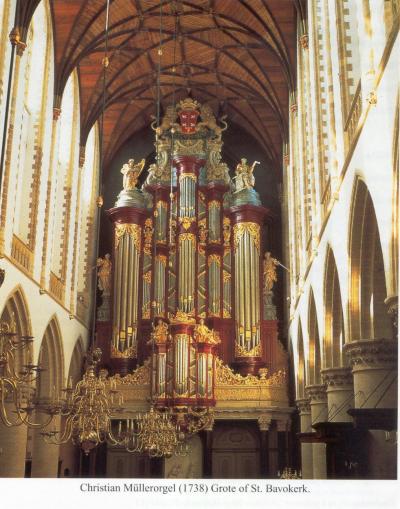
(All of observations about the "organ" are made only by the "sounds and features" of the Voxus sample set, and not based upon any other opinions or recordings.)
The Hoofdwerk is impressive to be sure. Sitting mightily in the front part of the grand case, it sings and dominates all the sounds that this instrument will make for the player and for the listener. That being said, it surprises me to see that the "principal chorus" is really quite a bit "smaller" than you would think. I say this because there is no "independent" 2' principal. It is "included" in the mixtuur ranks, but it is surprisingly absent from the principal chorus. While you do miss it, the Woudfluyt 2' makes an impact in the chorus, and while it's a lovely flute stop, it does work as a stand-in for the absent principal. There are two 16' foundation stops, the Praestant I-II and the Bourdon. The Praestant is very full-toned, and I found that I only used this with the "full organ." The flutes are represented in a complete "flute chorus" ranging from 16' to 2'. The Gemshoorn 4' is really much more a flute than it is a string. It's sort of a hybrid stop, but it leans significantly to the flute side. The mixture stops are intense, and can be used in a variety of ways. The "big" mixture, the Mixtuur IV–X 2'-8' is based on what I call the "16' series," and it can only be used with a 16' manual stop being drawn. If you don't use a 16' stop, you'll get what I call "false bass" notes, with an odd and "unusable" effect. The Scherp VI–VIII 11/2' is very bright, but is by no means "shrill or screamy." It crowns the plenum of the entire organ, and can be used in any number of combinations with other mixture stops. If you don't draw a 16' manual, the Scherp will be your main mixture stop. The Tertiaan II 2' is really a strong sesquialtera, and can be used to make a strong cornet-type combination, to add fire to a Trompet solo, or to really fill-out the full organ, assuming that you like/want the tierce in the plenum. Let's not forget the interesting Viola di Gamba 8. It's a sweet and gentle stop, and combines well with the sweet and full Roerfluyt 8'. The reeds are splendid, but keep in mind that these are essentially chorus reeds. If you want to use them as solo stops, say for instance using the Trompet 8' for the cantus firmus in something like Bach's Wachet auf, you'll be very pleased with the effect. However, if you think you'll use it as a brilliant reed in a "high-lying" register, you'll probably be disappointed. You can beef it up with the Octaaf I-II 8', but it really will not help all that much. Used in the lower and middle ranges, you'll find majesty and grandeur, but go up top, and the mixtures will have to carry the sound. The charming Hautbois 8' is a really sweet little stop! It can be used almost like an "English oboe" as part of a chorus. As a solo, it shines, assuming that you are not looking for a large or aggressive solo.
Moving down to the Rugwerk, positioned in the case "on the organloft rail" and behind the player. Like the Hoofdwerk above it, the Rugwerk is an impressive division, much more of a "small Hoofdwerk". It is the classic foil to the great organ, and certainly not an "English type" choir division. We find a complete principal chorus with the pitches of 8', 4' and 2' being present, and making a fine and full chorus. It is not a thin, or scrawny type of sound. It is full and splendid. Flutes are present in the following voices: the Holpyp 8', Quintadena 8', Fluyt Does 4', and the Speelfluyt 3'. The flutes are charming used as 8' alone, the 8'& 4', the 8' & 3' (2 2/3'), or the 8', 4', & 3'. The Quintadena 8' is colorful, and can be used alone, or very effectively in combination with the Holpyp 8'. The mixtures are substantial. The Mixtuur VI–VIII 1' is a great "top off" for the division's principal chorus. The Cymbaal III is very bright. I'm not sure if this is one of the mixtures that Marcussen revoiced, now "restored" by Flentrop, but it's bright, to be sure. The famous Cornet IV (Diskant) is placed right in the front of the case. It can be used to "outline for the congregation" the cantus during a hymn or psalm. The close position to the people help to project the sound in an impressive and distinctive manner. I guess you could say that this is "Müller English tuba" stop! The reeds are distinctive and versatile. The Fagot 16' reminds of the similar stop on the big Kampen Hinsz/Schnitger organ. It is sweet sounding as a solo, and makes a wonderful 16' "chorus stop", as demonstrated in the Bach Prelude and Fugue in C Major, BWV 547. It makes a colorful foundation without any of the "thickness" that the 16' Bourdon might produce. The Trompet 8' is coloful, but relatively small, which, like the Hoofdwerk is quite thin as it goes up the register. The Trechterregal 8' is a distinctive and expressive stop. It is plaintive and haunting with tremulant, and could be used to "color" certain choruses.
Moving up to the top manual, and also high up in the case, let's explore the Bovenwerk. It's a wonderful division, and let any "great classic organ" has a principal chorus present. Here again the 2' principal is not present, but we really do not miss it. Flutes are present in abundance with the Quintadena 16', Baarpyp 8', Quintadena 8', Flagfluyt 4', Nasaet 3', Nagthoorn 2', and Flageolet 1 1/2'. Mixtures are bright. I found the Mixtuur IV–VI 2' to be very fine, but the Cymbaal, which I believe is one of the stops revoiced by Marcussen, is very "tinkly." I don't think I used it in all but the fullest full organ. The reeds are distinctive. The Schalmey 8' is smooth and "round" and actually made think of an English cornopean at first hearing! It is the most "English" of the organ's reeds, and it is a very elegant stop. It also tends to not lose as much as you ascend into the higher registers. The Dolceaan 8' is something of a Krummhorn and makes a lovely solo voice. The Vox Humana 8' is another fine stop, which could be used as a small solo voice or in chords, and with or without the tremulant.
The Pedaal is a big division, as we would expect. We find principals at 32', 16', 8', 6' (5 1/3'), and 4', and while they are impressive and solid, they do not have the "boom and roll" that we would find and want in a big English cathedral instrument. The 32' is on the quiet side, and it's hard to imagine the old tale that says that the vibrations of this stop were so low, that "the mortar in between the brimstones started to brittle to nothing." (As an interesting side note, I was admonished by old Dean Le Grice, who was the dean at Ripon Cathedral while I was there, who told me that my "over use" of the 32' Open Wood was causing the cathedral's foundations to weaken, and that the building was actually shifting! Neither statement was true, I might add!) Flutes are present with Bourdon 16', Roerquint 12', Holfluyt 8, and Holfluyt 2'. I might add that the Hohfluyt is distinctive with a slightly "string-like" quality, and the Hohlfluyt 2' makes it's presence felt in a surprisingly telling way. The mixtures are big. Actually they are very big. The Mixtuur VI–X 2' is large, but it balances well with the plenum, while the Ruyschquint V 3' is really aggressive, and I found that it got very little usage. I believe that the original organ does not have the ability to use pedal couplers, and with mixtures like these, there is no need to even consider the need for couplers. The reeds are impressive, diverse and glorious, coming in with Bazuyn 32', Bazuyn 16', Trompet 8', Trompet 4', and Zink 2'. These stops are of course all "independent," meaning that there are no "units" or "extensions." The reeds are grand and awesome, whether finding use in solo and "foundational" capacities.
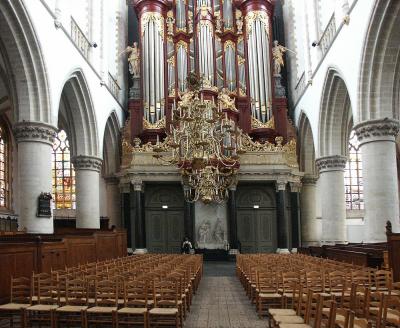
This is probably halfway down the Nave - perhaps a little less.
Having spent quite a few moments showing interesting and unusual details of the church, let me turn now toward my discussion about the sample set itself, the Müller Grote of Sint Bavo extended by Voxus. It's a big set, not cheap in cost, and requiring a lot of RAM. A little over a month ago, I did over 20 recordings using the sample set, uploading all of these on the Concert Hall. I hope that these recordings will serve to demonstrate the capabilities of the set, and try to answer the questions that I think that you as the reader, and as the potential purchaser of the set may have.
I'd like to take a moment to explain what I was trying to specifically demonstrate with the recordings.
Was Gott thut das ist wohlgetan (pleno Organo) by Krebs will serve to demonstrate the wonderful "small plenum" of the instrument.
https://www.contrebombarde.com/concerthall/music/20420
Herzlich thut mich verlagen, also by Krebs, shows the exquisite and unique Trechterregal 8' of the Rugwerk, which is here combined with the Quintadena and tremulant.
https://www.contrebombarde.com/concerthall/music/20422
The Orgelhymne "Wilt heden du treden voor God den Herre" by Jan Zwart, shows the full organ in various stages. I should mention that this is the only time that I've "gone beyond" the real limits of the organ, as the piece ends with a "high E-flat" and the organ ends on "D."
https://www.contrebombarde.com/concerthall/music/20426
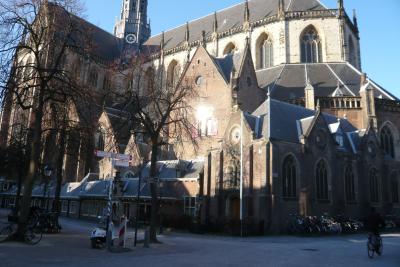
Looking from beyond the "east" end. Notice the bicycle park!
The unique piece Heer, blijf met mij, again by Zwart, based upon the English hymn, "Abide with me", we hear some of the soft solo stops of the organ, including the wonderful Hautbois of the Hoofdwerk, as well as some of the soft flutes and strings, and also the use of the 32' Principaal at the end is intimate and effective.
https://www.contrebombarde.com/concerthall/music/20429
Schmücke dich, o liebe Seele by Homilius shows a wonderful, shimmering "cornet combination" of the Bovenwerk. Sunlight gentle glistens from the sweet sounds.
https://www.contrebombarde.com/concerthall/music/20436
Wachet auf, ruft uns die Stimme, also by Homilius shows in a unique a magnificent way, the glorious reeds of the organ. The thunder of the FULL PEDAAL is truly glorious.
https://www.contrebombarde.com/concerthall/music/20437
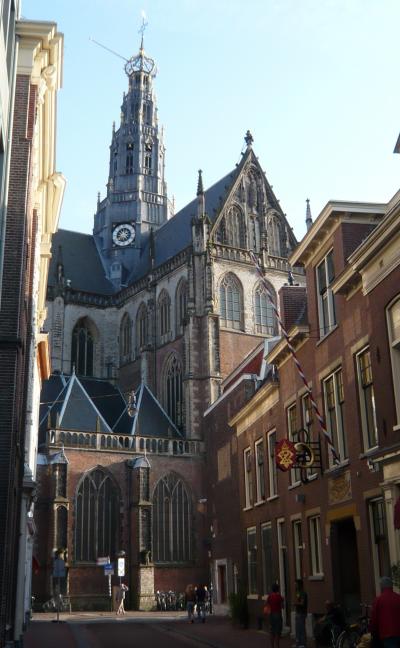
A beautiful side-street view.
I took a bit of a "chance" in uploading the Suite du deuxième ton by Clérambault. I say "chance," since this is not the "correct" organ for this music. However, I think the result is very grand, and entirely appealing, if not always as "perfect" as it would be on a true French baroque instrument. I would call attention to the unusual Grosse tierce, the exquisite flutes, and the highly colorful interplay of sounds. The reeds don't have the "fire" that the French ones do, and the mixtures I chose were a bit too "aggressive," but the sounds are musical, beautiful, and stand on their own merits!
https://www.contrebombarde.com/concerthall/music/20500
Many listeners found that Bach's coloratura setting of Nun komm der Heiden Heiland, BWV 659 to be extremely beautiful and satisfying. The sweet and strong "cornet" of the Rugwerk is powerful enough to allow the accompaniment to played upon the smooth Octaaf 8' (principal) of the Hoofdwerk. The music soars and sings, with every amount of the intense emotion wrung out and rung out!
https://www.contrebombarde.com/concerthall/music/20438
En gammal fäbodpsalm från Dalarna by Lindberg fares very well on this organ. The score calls for a "Krummhorn", which is hear played upon the Dolceaan 8' (combined with the two flutes in a variety of ways) of the Bovenwerk takes the solo with sweet, sorrowful, and stately tone.
https://www.contrebombarde.com/concerthall/music/20487
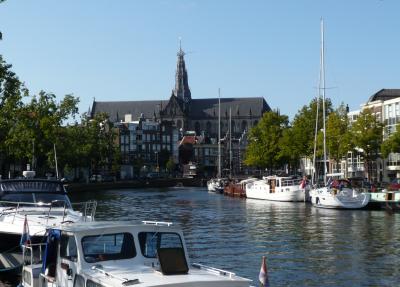
From the canal.
Kleine Präludien und Intermezzi, Werk 9 by Hermann Schroeder show that this organ handles modern music as well as it does music of the baroque period. It is true that you may sometimes miss a swell pedal, but the variety of colors available on the organ will more than compensate for this "shortcoming."
https://www.contrebombarde.com/concerthall/music/20512
A unique feature/s of this organ is the great carillon, as well as two bells, the lowest and oldest, that used to ring the warning of the closing of the city gates. Listened from the "inside" of the church, meaning at the same level that you would have used the organ, you'll find that the sound is very distant. In order to show the sound and power of the carillon, I increased the volume level considerably. It is true that doing so increases the "background noises," but the "effect" created by doing this, sort of replicates "street noise," so, the effect is not at all unpleasant. For this upload, I played an old Dutch tune, and then rang the time and tolled the bell.
https://www.contrebombarde.com/concerthall/music/20528
Maria zart, von Edler art by Schlick demonstrates the famous sharp and powerful Cornet of the Rugwerk. It may be "sharp and powerful," but it is also beautiful.
https://www.contrebombarde.com/concerthall/music/20529
Jubilate by William Mathias is a real tour de force and just dances and thunders on the big Müller. The sounds are brilliant, and swirl and dance in the massive acoustic. The piece ends with absolute full organ, and the last chord rolls on in the echo for a L - O - N - G time.
https://www.contrebombarde.com/concerthall/music/20455
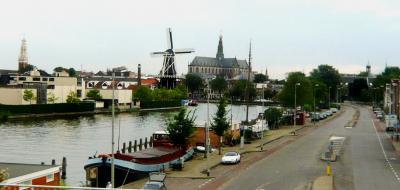
A perfect picture.
In conclusion of the recording demos, I did a number of the great Bach Prelude and Fugue in C major, BWV 547. They are done with a variety of stops and locations, and are worth listening to for sound/distant perspectives.
https://www.contrebombarde.com/concerthall/music/20663
https://www.contrebombarde.com/concerthall/music/20664
https://www.contrebombarde.com/concerthall/music/20792
On my computer, the organ just fits in my 64 GB of RAM, loading it at full detail, 24-bit, and with lossless compression. I generally load my sets in uncompressed detail, but to be honest, I can not detect any difference or "lower quality" in sound.
The graphics of the sample set are also high quality, but simple. I call them "simple" because the working screens are display a "stop board" for those, like me, using a single computer screen, or the stops in divided display. There is another screen that has the slider to determine the distance of the listening perspective you wish to use.
I found the slider works very well, and really and "accurately" allows you to find "your" spot. Mine seemed to be about 2/3 of the way "down" the nave, meaning "away" from the organ, and not nearer to it. I am not normally a fan of the "console listening spot," but in this case, I both liked it and found it effective. As was pointed out to me, the "console spot" might not be actually "at" the console, but "at the organ," meaning perhaps "higher up" on the main case, as if this is where the microphones used to make the recordings was placed. Whether "at" or "near," I found it pleasing, successful, and exciting.
As to the sample set being "worth the price," I would say yes, but of course, that depends on your budget, the frequency that you purchase sample sets, your personal preference in organ "type", and the amount of usage that you feel that you would get from this, or any sample set.
In making these recordings, I tried to limit myself to using only this sample set during the recording period. I tried to immerse myself in the sounds, sensations and persona of this organ. I found the experience a deeply intense one, and truly enjoyed having the opportunity to play this instrument - even if only in a "virtual" setting.
One last look upward to an instrument that is surely "divinely" inspired.
My SINCERE THANKS and appreciation to Voxus organs! I'd have to say that this sample set deserves a BIG BRAVO and 2 THUMBS UP!
Comments